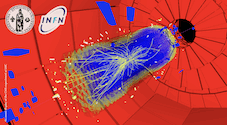Speaker
Description
Summary
The ATLAS experiment at the LHC is equipped with a charged particle tracking system,
the Inner Detector, built on three subdetectors, which provide high precision
measurements made from a fine detector granularity. The Pixel and microstrip (SCT)
subdetectors, which use the silicon technology, are complemented with the Transition
Radiation Tracker.
Since the LHC startup in 2009, the ATLAS inner tracker has played a central role in
many ATLAS physics analyses. Rapid improvements in the calibration and alignment of
the detector allowed it to reach nearly the nominal performance in the timespan of a few
months. The tracking performance proved to be stable as the LHC luminosity increased
by five orders of magnitude during the 2010 proton run, while the performance was only
slightly degraded in the extremely dense heavy ion collisions. New developments in the
offline reconstruction for the 2011 run will improve the tracking performance in high
pile-up conditions, as well as in highly boosted jets.
(Abstract submitted by the ATLAS Inner Detector Speaker Committee.
The speaker will be defined later)

